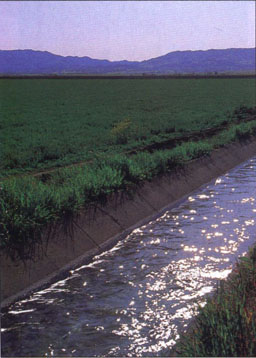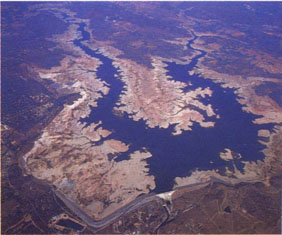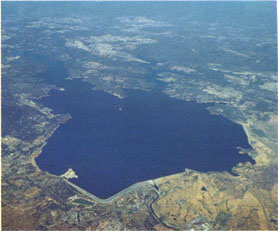All Issues
Q & A: Devising a water strategy for the 21st century
Publication Information
California Agriculture 53(1):8-10.
Published January 01, 1999
PDF | Citation | Permissions
Full text
CA: What are the dimensions of California's water problem, and how are they expected to change in the next century?
HJV: There are at least three major challenges and they are not limited to California; to a significant extent they will have to be confronted by virtually every region of the world. These challenges are (1) intensifying water scarcity, (2) the continued deterioration of aquatic habitats; and (3) the need for effective institutions to manage these limited resources.
CA: Let's talk about each of these in turn. Is it inevitable that scarcity will intensify?
HJV: As complicated and contentious as water allocation in the Sacramento/San Joaquin basins has been, it merely foreshadows the increasingly difficult allocation issues likely to converge in California and around the world. For example, on a global scale one estimate suggests that as much as 2,000 km3 (1.62 billion acre-feet) of additional water may be needed to grow crops to feed the population increase of more than 2.3 billion people projected to occur by 2030.
It is not at all obvious where such additional water will come from. Many of the world's major rivers are already tapped out during the dry season; ground water is being over-pumped in many of the world's major crop growing regions; and global agriculture is under the same sorts of competitive pressures from cities and, to a lesser extent, the environment as it is here in the U.S. The evidence suggests that over the next two or three decades, we will begin to push hard against the limits of available water supplies in California and on a worldwide basis.
CA: Why do environmental water problems assume so much importance?
HJV: Obviously, there are a number of explanations, but I think the major one is that in this century, the predominant means of dealing with water scarcity has been to construct storage and conveyance facilities - namely, dams. While construction of these dams was important in fueling economic development and servicing legitimate water demands, the builders paid virtually no attention to the environmental and ecological consequences of impounding waters and altering flow regimes.
The widespread draining of wetlands and destruction of estuaries has also contributed significantly to the degradation of aquatic habitats. Monuments to the ecological destruction of the water management and development schemes of the 20th century abound: the Colorado River Delta, Aral Sea, south Florida Everglades, Ganges Delta … these aquatic ecosystems collapsed because of inattention or ineptitude in the devising of water management strategies.
Every day we learn more about the value of aquatic ecosystems. They provide critical services such as water and air purification, habitat for aquatic organisms and environmental stability. When the capacity of the environment to provide such services is impaired or destroyed, providing them by other means is enormously expensive and much less efficient. We must find alternative ways to stretch our water supplies that preserve the integrity of aquatic ecosystems.
CA: What are some of the most promising ways of stretching supplies to meet environmental needs and the demands of a growing population?
HJV: Conventional methods such as the use of drought-tolerant landscape plants, sophisticated irrigation technology and appropriate water pricing policies will remain important. In my view, reclaimed water represents perhaps the most significant source of “new” water supplies, though it may be too expensive in some lesser-developed regions. (Related story on page 11.) Some of the most innovative work is under way in Orange County, California, where the latest technologies are employed to recycle water and make it available for a variety of uses, including direct groundwater recharge.
CA: Are there risks to public health from using reclaimed water?
HJV: A group of experts appointed by the National Research Council recently examined this question. They concluded that planned indirect potable use of appropriately treated reclaimed water is viable, providing that there is careful monitoring, safety testing and periodic evaluation of system reliability. Few people realize that we have the capability to clean our reclaimed water to the point where it is cleaner than the water many Californians now drink. As for the environment, existing data do not suggest negative environmental impacts from using reclaimed water. But obviously, there must be continual monitoring of all reclaimed water, for all uses.
CA: Besides high-tech approaches like modern water recycling, are there promising institutional approaches to stretching our limited water supplies?
HJV: Water privatization and marketing will, I think, significantly increase efficiency of water use and allocation in the years to come. Farmers are already trading water in several Western states, including parts of California. But water markets - or any market-like strategies, for that matter - will not solve California's water problems by themselves.
CA: Can you elaborate?
HJV: California's water management system probably needs to be overhauled at some point. Most of California's water laws and institutions were designed for another era. They do not allow for flexibility and the kind of adaptive management we need so badly now. California's water management organizations are highly fragmented, with the many state and federal agencies involved often unaware of what the others are doing. We probably need to forge a system that is more collaborative and comprehensive. There are a number of fundamental questions that we need to address. For example, what is the role of the private sector in managing water resources? To what extent should we rely on market-like mechanisms such as the drought water bank and to what extent should we rely on more centralized rules and regulations?
CA: Does the University have a role to play in all of this?
HJV: UC and the higher education community have an important role to play in generating the research that will be needed to undergird the development of new water management regimes and technologies.
CA: Are our national water resource research efforts adequate to the task?
HJV: In an era of highly constrained public resources, we must be more systematic and strategic in planning our water research agenda. At present, the creation of water research agendas and priorities is highly decentralized. There are no processes or mechanisms, either formal or informal, for identifying the nation's water research and development priorities - or even for prioritizing the nation's water problems on a unified basis. Some 12 federal agencies are involved with water research programs, and to these can be added many state and private agencies and a smattering of local agencies. These agencies tend to act independently with the result that investment in research and development may be duplicative even while some critical research topics fall through the cracks.
Photographs of Folsom Dam near Sacramento illustrate the variability of California's water supply: Water levels at the height of the 1976-1977 drought.
Current water research conducted by agencies focuses on correcting errors of the past or on dealing with unanticipated or unintended consequences that adequate research might have averted in the first place. Much agency research is not forward-looking or focused on problems of the future.
In addition, the water management job is being made harder by the systematic downgrading and de-emphasis of certain kinds of data collection efforts. For example, over the last decade, the U.S. Congress has failed to provide adequate funding just to maintain the national network of stream gauges managed by the U.S. Geological Survey. In addition, agency funding to support water resource research is lower now in real terms than it was in the late 1960s. By almost any measure, funding to support water resources research is inadequate.
CA: Which disciplines will be most important in driving this new research agenda?
HJV: The research must have a significant multidisciplinary component and must be balanced. For many years of the 20th century, engineering-type research dominated. One consequence was that the environmental impacts of many engineering works were unforeseen and misunderstood.
CA: Are efforts underway to strengthen water resources research nationally?
HJV: The National Water Initiative, which was developed by my AAAS symposium co-organizer Ted Hullar (director of Cornell's Center for the Environment), would align state and federal governments, research universities, users and purveyors of all kinds, nonprofit organizations and public interest groups. This initiative would be a federally funded program sponsoring water resources research. It would be coordinated through a national body, such as the National Science Foundation (NSF). I think it could spawn substantial improvements in the national water research program.
CA: Doesn't centralized oversight imply a loss of determination among water users?
HJV: No - quite the contrary. Ideally, a more strategic process of research agenda-setting would let academic researchers, users and purveyors of water - the people who best understand water problems in their areas - participate in the process of establishing research agendas. A National Water Research Board patterned after the NSF's National Science Board might set the national water research agenda.
CA: California is the nation's most urbanized state as well as its number-one agricultural state, and water conflicts are often portrayed as a battle between agricultural and urban water users.
Do you view them that way?
HJV: As the user of 75% of the state's developed water supplies, California agriculture is obviously positioned to meet increasing challenges from other water interests, especially environmental users. But it is important to remember that agricultural and environmental uses are not mutually exclusive. A prime example is winter flooding of ricelands to provide water-fowl habitat. I see the problem more as one of education - or, rather, inadequate education. We must do a better job of explaining the science behind water quality and quantity issues both to the public and to the policy makers. And we must have more resources to do the scientific research that will guide water management in the 21st century. - Jill Goetz, interviewer









